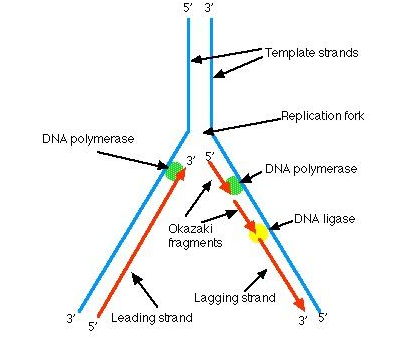The fact that eukaryotic chromosomes are linear duplexes introduces a problem for eukaryotic DNA replication that does not exist for circular bacterial DNA replication. The ends of eukaryotic chromosomes, termed telomeres, have a G-rich strand that ends in a 3'single stranded overhang.
Semiconservative replication initiates at origins internal to the telomeric repeats and the replication forks move toward the chromosome ends. Because of the structural arrangement in telomeres, the C-rich strand is always assembled by lagging-strand synthesis and the G-rich strand (denoted by G) is always assembled by leading-strand synthesis.
Before the structure of the telomere was elucidated, investigators thought that lagging strand synthesis might present a problem because removing the RNA primer at the 5'-end of the last Okazaki fragment would produce a shortened new C-rich strand. However, new C-rich strand synthesis does not necessarily present a problem for the replication machinery because the G-rich stand has a 3'-over-hang. Therefore, the RNA primer at the end of the last Okazaki fragment can be removed without the loss of information.
In contrast, leading strand replication presents a serious problem because replication of the new G-rich strand will stop at the 5'-end of the C-rich template strand to produce a blunt end with a resulting loss of sequence information. The leading strand problem is thought to be solved by using a 5'→3'exonuclease to generate a 3' over-hang. Unless something is done to restore the lost sequence, this processing step will cause the telomere to become shorter. If this shortening process were to continue through several more replication cycles, then the telomere would be lost entirely and the chromosome would no longer be able to survive as an independent replicating unit. The lead-1ng strand problem is solved by telomerase, a specialized polymerase that adds telomeric DNA sequences onto chromosome ends.








